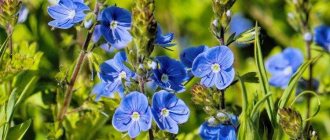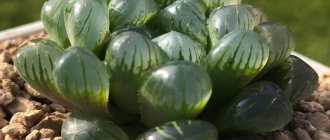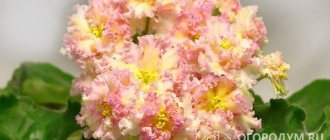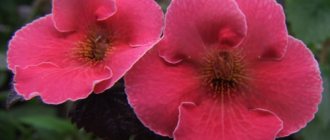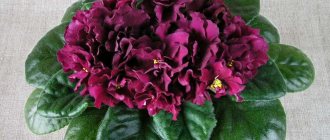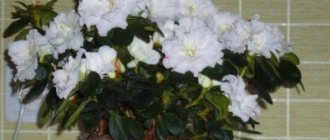Callas belong to the Araceae family. This plant is a perennial, grows in coastal and swampy areas, on the continents of Eurasia, North America and Africa, where a temperate and subtropical climate prevails.
For a flower, calla lilies have an unusual appearance, the stem length is about 80 cm. But this is not the limit, there are also taller varieties. The root system of the calliper is hollow rhizomes with shoots, the total length of which is from 60 to 90 cm. Bright green large leaves reach 30 cm in length, located near the rhizome. They are used in folk medicine as an anti-inflammatory agent.
Flowers similar to Calla lilies
There are two plants incredibly similar to Calla lilies - Spathiphyllum and Anthurium. They are just as beautiful and undoubtedly deserve attention.
Anthurium fire element. It blazes along with the red Calla, Spathiphyllium - “Snow White”. Its flower, as if descended from the mountain peaks, can boldly resist the whiteness of the bride’s dress.
All these plants (including Callas) belong to the Araceae genus. They arrived at the house of a man from the tropics: South America, Argentina, Paraguay and Mexico.
Symbolism
Callas are considered a symbol of love and prosperity. It is not for nothing that the culture is often used to create wedding bouquets. According to popular beliefs, culture has several magical properties:
- Callas protect the house or apartment where they are located, protect them from stressful and unpleasant situations;
- Plants symbolize peace and harmony. For example, calla lilies will help in establishing relationships with a child if you put flowers in the nursery. In the marital bedroom, calla lilies are a welcome guest. Sexual energy, passion and love emanate from the plant;
- Calla lilies have a positive effect on health . Thus, there is a belief that if you give a bouquet of calla lilies to a sick person, he will recover faster.
Callas are often used to create wedding bouquets, as they symbolize family happiness and well-being of future spouses. The presence of a flower in a bride’s bouquet emphasizes femininity and the beauty of youth.
The culture is also considered a talisman against the evil eye for young girls. Moreover, this applies not only to living plants, but also to images with them that are placed in the apartment.
Why are plants called “flowers of death”?
Callas are often called “flowers of death.” But the point is not at all that these flowers attract death. In the West, it is customary to bring white flowers to graves. And calla lilies are very popular. In addition, they are grown in the cemetery.
In this regard, plants should not be given to elderly women, since such a bouquet hints at their imminent death. And in some European countries, for example in Great Britain, it is completely prohibited to give bouquets of white callas.
Signs
There are signs associated with the use and maintenance of these plants.
Callas are a symbol of happiness and prosperity, so plants help remove quarrels and conflicts in families. Plants can even be given in pairs - this will not be considered a sign of mourning.
Despite the custom in Europe of bringing calla lilies to funerals, the plants themselves are not a magnet for death and other misfortunes.
A plant grown in a room gives a boost of energy to owners and also calms the nerves. In addition, there is a belief that calla lilies strengthen the immune system.
Description of plants similar to calla lilies
In indoor floriculture, there are several types of plants similar to calla lilies.
Spathiphyllum
Spathiphyllum also belongs to the Araceae family. Depending on the variety, it grows from 50 to 150 centimeters in height. Its bright green or variegated foliage is collected in a basal tuft. It has an ovoid shape, in some varieties its structure resembles corrugation. The length ranges from 25 to 90 centimeters, and the width from 10 to 40 centimeters. A spathiphyllum flower consists of a yellow or greenish-colored spadix and a spathe.
Unlike calla lilies, the spathiphyllum cover has an oval shape and is located vertically. By the end of flowering, its white color turns greenish.
Anthurium
Anthurium is an evergreen plant belonging to the Araceae. It can reach more than a meter in height. Anthurium has shiny, tough, solid foliage of a dark green color. It is heart-shaped and up to 40 centimeters long. The flower spadix may be white, pink or yellow.
Unlike calla lilies, the bract, like the leaves of the plant, is heart-shaped and is located around the cob, perpendicular to it.
The blanket can be white, salmon, pink or purple. But, for some reason, today varieties that have only red flowers are most often grown. People often call them “tongues of fire”, “flamingo flowers” or “men’s happiness”. It is believed that anthurium gives a man strength and brings happiness and good luck to his home.
Zantedeschia
Zantedeschia, like callas, is a perennial flowering plant belonging to the Araceae. Its underground part can be either a rhizome or a bulb. Depending on the type, its bushes can produce stems from 50 centimeters to 1 meter in height.
The foliage of the plant is bright green in color and heart-shaped. The appearance of the flower resembles a calla lily. It consists of a yellow cob and, depending on the varietal variety, can be white, pink, greenish, yellow, cream with a lemon tint, lilac-cherry, dark purple.
Whitewing
Calla palustris is a member of the evergreen perennials of the Araceae family. It is a small compact plant about 30 centimeters tall. Its heart-shaped green foliage in some varietal specimens may be covered with white or yellowish spots. They have a length from 6 to 14 centimeters and a width from 5 to 11 centimeters. The ear of the calla lily, like that of calla lilies, is yellow in color. The inside of the bedspread is painted white, and the outside is greenish.
There are not many indoor flowers that look like calla lilies. But, in addition to the fact that they belong to the same family and have some visible similarities, they also have a number of clearly visible differences, for example, in the shape of foliage and bedspread. Therefore, having studied the features of their structure, you can easily determine their name. This will help determine their further content, which will contribute to the proper development and abundant flowering of plants.
More about red Anthurium
Like any plant, Anthurium also has its own symbols, bringing its joys to the house. It is believed that Anthurium is a symbol of masculinity, which helps a man gain strength and courage, become a protector and the real head of his family. Anthurium is nicknamed the fire flower for its amazingly bright color. Translated from ancient Greek “flower with a tail.” Indeed, the beauty of artificial calla lilies is incredible, a bright, red petal with a small tail, which can also be of different shades depending on the plant variety. By purchasing “male happiness” for your home, you take on the responsibility for careful and painstaking care, since the flower is extremely picky. That is why you should take care in advance to study information on caring for the plant and study all the features of its cultivation.
Ethiopian calla (Zantedeschia aethiopica)
Calla Ethiopian is the largest variety of Zantedeschia for growing indoors. This species has large heart-shaped leaves and funnel-shaped inflorescences. During the dormant period, the foliage remains bright green, which increases the decorative appearance of the species.
The most famous varieties of Ethiopian calla lilies include:
- “Green Goddess” is a variety with white-green flowers and a short lemon-colored stamen.
- “Childsiana” - the variety blooms profusely with snow-white flowers with an orange center.
- “Amethyst” is a variety of purple calla lilies that are distinguished by their considerable height and delicate aroma.
- “Pearl” is a tall variety with light green leaves, the flowers are large, white, fragrant, with a greenish tint on the outside. Suitable for bouquets.
- "Albomaculata" - a large white flower with a candle shape and a light vanilla aroma.
- "Captain Chelsea" is a beautiful two-color variety. The bedspread is burgundy with a golden border. The leaves are dark green with silver dots.
- "Little Gem" - calla has white flowers of the original appearance. A flower that has not fully blossomed has a petal that curls like a funnel, with a bright yellow stamen in the middle. At the edge of the petal there is a greenish outgrowth-claw.
Photo
Black
Black calla Odessa in a pot will decorate the windowsill with its elegant, almost black flowers.
Dark callas are exquisite and original plants, distinguished by the unusual, almost black color of their flowers. Compositions with calla lilies of dark and white colors are successful.
Callas of different colors in a vase.
Reds
Red callas in a Red Alert pot stand out with their bright red flowers against the background of green foliage.
White
Magnificent varietal variety Captain Ventura with snow-white flowers in bouquets.
Yellow
Spectacular Florex Gold with bright neon yellow flowers in a pot.
Pink
Photo of flowers of the Captain Rosette variety with soft pink bracts in bouquets.
Pale pink Samur growing in a basket.
In bouquets and container plantings, dark and light callas, including pink varieties, are often combined. In this photo there are varieties Schwarzwalder and Captain Rosette.
Burgundy
The Black Star variety, grown in an outdoor container, is distinguished by the rich color of its bracts.
Orange
Captain Safari with bright orange flowers in bouquets.
Multicolored
Multi-colored Zantedeschia varieties Picasso, lily and allium.
Zantedeschia Vermeer in a pot.
Blue and light blue
Let us note right away: such varieties do not exist! The photo below shows either artificial flowers or painted ones.
An incredibly delicate bouquet of blue callas Wedgwood Blue.
Wedding bouquet of callas called Deep Blue.
Purple and lilac
A bright and spectacular bouquet of calla lilies of the Purple Sensation variety.
Light purple callas in an Amethyst pot.
Problems with indoor calla lilies and their solutions
| Problem | Cause | Solution |
| The stems are stretched. | Not enough light, very warm. | Change the location, install additional lighting, lower the room temperature. |
| The plant does not bloom. | The rest period has not been maintained. | During wintering, stop watering and reduce lighting. Before flowering, fertilize. If the rhizome grows large, divide it or plant the tubers. |
| Fragility of petioles. | Lack of nutrition. | Fertilize every week with fertilizers containing nitrogen and superphosphate. |
| Plaque on the leaves. | Fungal disease powdery mildew or gray rot. | Treat the leaves with a solution of potassium permanganate or soda ash with soap. Spray with fungicidal preparations: Fundazol, Vecta, Topaz, etc. |
| Non-seasonal leaf shedding. | Root rot. | Reduce watering, replace the soil. |
Breeding in the garden
Incredible calla lily flowers, when grown in the garden, create an exotic and unique landscape. It should be planted in the flower garden no earlier than May. Before this, it is necessary to cut off the damaged parts and treat the plant.
- It is better to choose a site for a flower bed in partial shade.
- Soil: loosen and add mineral fertilizers.
- Planting: tubers are immersed to a depth of 5-10 cm, at a distance of 30-40 cm, the rhizomes are lightly sprinkled with earth, otherwise rotting will begin.
- Watering: The first irrigation should be plentiful, then stop for a couple of weeks.
- Additional activities: loosening the soil and removing weeds.
vote
Article rating
Tuberous indoor callas
Callas sprouted from tubers, unlike those that feed on rhizomes, do not require high soil and air humidity, but do not tolerate drought well. It is optimal to carry out regular watering, avoiding waterlogging of the soil and preventing the soil from drying out, forming cracks.
The homeland of indoor plants is still South America. Thanks to the work of breeders, it became possible to grow the free-spirited beauty in pots on windowsills, without limiting oneself to snow-white varieties at all.
Elliott
When callas of this variety bloom, you can observe harmonious tints: the outer surface of the petal is light green, the inner surface is bright yellow. The variety blooms profusely, which cannot but please gardeners. The window sill will be a bright accent in the room for many summer months.
Aethiopica
The most popular variety of indoor plant is aethiopica. The flowering is distinguished by a dense funnel, widening towards the top. The flower stalk can reach a meter in height, with the right choice of pot and a sufficient amount of diffused light. White callas love moisture more than other varieties of tuberous representatives of this family. Therefore, to obtain abundant flowering, it is important to keep the soil in the pot moist.
Attention! If the top layer of soil looks dry, but already at a depth of 1 cm the soil is moist, there is no need to water the plant - this will lead to excess moisture, which can contribute to the rotting of the tuber.
Picasso
Calla variety Picasso is distinguished by the uneven color of the inner side of the petal. The core is colored purple, going deep, creating a contrasting background for the yellow cob of the core. The edges of the inner side and the entire outer surface are white. Growing calla lilies of this variety in a pot requires the presence of water in the tray. The room temperature should be close to 22˚C.
Odessa
Calla variety Odessa has won the hearts of lovers of wine shades. With sufficient lighting, it can acquire a dark ruby color, sometimes very close to black. Callas do not differ in flowering duration from the standard indicators of their relatives - from July to the first days of September, the flower will delight with its deep, rich color.
Attention! All tuberous and rhizomatous callas are not frost-resistant and are not able to withstand frost without outside help. Therefore, tuberous varieties are cleaned of dried leaves, the tuber is wrapped in cloth and stored in a ventilated container in a cool, dark place.
Mango
The variety got its name because the blooming calla lilies resemble mangoes in color. Sometimes it may even seem that someone has laid out the ripe fruits of a tropical plant among the greenery - this is how calla lilies bloom lusciously and give a subtle sweet aroma. A bright picture can be observed from the beginning of August, when the first petals appear. The rest of the spring-summer period, the plant increases its green mass in order to gain strength for luscious flowering.
This variety requires 12 hours of daylight, which ensures rich shade.
Callas Mix are the most adapted to apartment maintenance; they are also called the colored variety. They are less afraid of drafts and temperature changes, but still you should not intentionally create extreme conditions even for such a resistant variety, so as not to shorten the flowering period. The petal can take on several shades: from pink to purple. Callas of this variety are called mix because the flowering options are ambiguous.
What it is?
Calla lilies: photos with descriptions, types of flowers, care features, growing secrets and recommendations from gardeners
Garden calla lilies are a fairly unpretentious type of plant if you adhere to certain care conditions. One of the main difficulties that you may encounter while growing garden calla lilies is storing them during the winter cold.
It is very important for this type of plant to be dormant when it is winter outside.
It is worth noting that this type of flower can be grown both at home, that is, in a pot on the windowsill, and in open ground in a flower bed. The flowering period is from June to September.
Since this flower is native to South Africa, its natural habitat is the banks of bodies of water, such as rivers or lakes. Also in nature, such a flower can be found growing in heavy muddy soil.
By planting calla lilies in your yard, you will get a kind of mat of stems and foliage, from which flower stalks will grow during the flowering period. Therefore, it is best to choose a relatively open place for planting, where the plant can grow luxuriantly. How can you place your “green friend” in an open and dark area at the same time? The fact is that calla lilies can grow in both cases, the differences will be as follows:
- in dark areas this type of flower will be characterized by vigorous flowering;
- in more open and sunny areas you can grow a plant with beautiful foliage, but with less lush flower stalks.
Street calla or, as it is also called, calla lily, is a representative of the genus of the araceae family. Previously, this genus was understood more broadly, which is why most aroid species that are grown as a houseplant or for cutting began to be called calla lilies. First of all, this name is typical for plants from South Africa - Zantedeschia, in particular for Zantedeschia Elliott and Zantedeschia Ethiopian.
We present to your attention several of the most popular varieties of Ethiopian calla lilies and Elliott calla lilies among gardeners, with the help of which you can bring to life even the most daring ideas and make your flowerbed extraordinarily beautiful.
Calla "Amethyst". Since ancient times, this variety has been considered one of the best plants that can be used to decorate the chambers of a noble lady. Distinctive features are a pleasant and refined aroma during the flowering period of the plant, as well as the color of the petals - soft violet. The height of a flower depends entirely on its growing conditions: it can reach from 60 centimeters to 1.2 meters.
Calla "Vermeer". It is a beautiful flower, which is characterized by a variety of colors and contrasts. The flower itself has a dark red color, and along the edges it turns into a snow-white edging. The richly colored petals cover the bright yellow spadix of the plant, thereby creating a contrast of colors. The foliage of this variety of garden calla is characterized by white specks. The growth of calla "Vermeer" will not exceed 70 centimeters.
Ethiopian calla lily rhizome. It is better to plant this type of flower in an area with a high level of humidity, then it can quickly take root. Also likes slightly shaded places. The flowers of the rhizomatous Ethiopian calla lily are large and have a pleasant white hue.
Tuberous callas. Unlike the previous variety, tuberous callas do not need moist soil to take root and feel comfortable. Such flowers can be planted in a flower garden. Like many other varieties of calla lilies, this one is preferably planted in a shaded area.
After familiarizing yourself with the most common varieties of garden callas, you can choose the one that is best suited for your soil and area.
Flowers that look like calla lilies
Indoor plants serve as a real decoration for the home and give it comfort and elegance, but in addition to their aesthetic function, they also serve as air purifiers. Indoor flowers with snow-white buds look especially elegant and delicate.
Overview of species
Indoor plants with white flowers are quite numerous and varied. They differ in both appearance and care requirements, but they are united by the white color of their buds.
Azalea
At home, this evergreen shrub grows no higher than 50 cm. Thanks to its lush and long-lasting flowering, the plant has gained extreme popularity. Large azalea buds are simple and double, the leaves are lanceolate, densely pubescent on the reverse side and located on branched shoots. Two varieties are most suitable for home cultivation: Melina (Japanese) and Stella Maris (Indian).
- The Japanese one has a more compact size and a highly decorative appearance; the entire bush is densely strewn with small buds. They can grow either singly or in inflorescences.
- Indian has dark green oval leaf blades and rather large buds. The central petals are strewn with crimson splashes. Flowers can be of different types: simple, double or corrugated.
Gardenia
The evergreen plant can grow either as a compact bush or as a tiny tree. In an apartment, the flower reaches a maximum height of 70-100 cm. Dense small leaves have a glossy surface with pronounced venation and grow in 2 or 3 pieces. The flowers are tubular, with a pronounced pleasant aroma. The most popular variety is the jasmine gardenia.
Large white-cream buds smell strongly of jasmine and form corymbose inflorescences of 4-6 pieces.
The plant belongs to vines, so it needs support. The leaf blades are oval in shape, at first they have a glossy surface and then become matte. The buds are not particularly large, but have an unusual star-shaped shape and form small inflorescences. The flowers are mainly white, but in the middle they acquire red or crimson shades. The following varieties of hoya are suitable for growing indoors: green, beautiful, motoskei.
Spathiphyllum
This striking representative of the aroids is distinguished by a very impressive appearance and the absence of pronounced shoots, very similar to calla lilies. Elongated leaf blades grow almost from the root. The flowers also have a rather unusual appearance: on the flower arrow there is a yellow spadix, wrapped in a white blanket of wide petals. The plant has many varieties, both tall and dwarf.
Among them the most famous are: “Abundantly Flowering”, “Picasso”, “Chopin”, “Sensation”, “Cannoleaf”.
White orchid
The plant is distinguished by a thick stem on which large buds grow. White flowers are rare; most often the petals have an edging or inclusions of a different color. The most popular varieties with white petals include the following:
- “Royal” is distinguished by large flowers, about 15 cm in diameter;
- "Vanda" is characterized by long flowering and a pleasant caramel scent of small flowers;
- “Butterfly” is distinguished by unusual petals, shaped like insect wings;
- "Heron" has flowers that resemble a bird in flight.
Stephanotis
Of the many plant species, only Stephanotis floribunda, a profusely flowering liana, is cultivated. The small leaves are oval in shape and have a glossy surface. The stems are quite flexible, although thick, and can easily be formed into a bush on supports. The flowers consist of 5 petals, have a waxy surface and are collected in small bunches.
Plumeria
The plant is noteworthy for its unusual aroma, which is more intense in the morning and becomes weaker in the evening. It combines citrus and jasmine scents with notes of lily of the valley and spices.
Indoor plumeria can grow up to 2 m and can look like a bush or tree.
The leaf blades are quite large, the surface below has white pubescence. The flowers are small, with five petals, the center of which is bright yellow.
Features of caring for and growing anthurium
Anthurium is considered a special plant, as it differs from its fellow Araceae family. It is distinguished for its exceptional aroma, but also for its abundant and beautiful flowering. Therefore, the plant needs special care.
Choosing a pot and soil
Surprisingly, Anthurium does not like large spaces. When choosing a pot, you should take this feature into account and make sure that the roots are as crowded as possible. If there is a lot of space, the plant will waste energy on root growth, while the soil will begin to oxidize, the tops of the leaves will be sparse, and there will be no flowering. It is better to choose a long pot, as the roots like to grow in length. Anthurium prefers oxygen-saturated soil, so it is replanted annually in the spring. The soil mixture is used with expanded clay. It is good when there is moss or peat in the soil. After transplantation, holes are made along the edge, this helps saturate the ground with oxygen, which promotes active flowering of the anthurium.
Required temperature
The flower comes from tropical places, so it loves warmth and humidity. Throughout the year, the temperature in the room must be maintained so that the flower does not fade and blooms profusely. The required temperature for Anthurium is from 20 to 28 degrees. Direct sunlight is harmful to the plant, so it should be protected from it. In winter, the temperature should be maintained between 13 and 22 degrees. To make the anthurium bloom faster, you can raise the temperature to summer standards. It is only important to take into account that the buds are formed at winter temperatures.
Air humidity
The plant came to us from a tropical area; it also likes high air humidity. It is necessary to provide the plant with good moisture. But the main thing is not to overdo it, otherwise the roots of the plant will begin to rot and it will simply die. To prevent the plant from being completely submerged in water, place moistened pebbles and a pot in the tray. This way the indoor plant will receive the necessary moisture. Also, the plant must be sprayed with a spray bottle, or the leaves must be wiped with a dampened cloth, while making sure that moisture does not get on the inflorescences. If the house has a humidifier, then it is better to place the flower next to it, and the humidity should be more than 75%. This creates a tropical effect for the anthurium.
Lighting
Light affects the flowering of a plant. If there is not enough natural light, the flower will look sluggish. Anthurium loves soft and diffused light. Anthurium is a very soft and delicate plant, so the sun can burn its leaves or even destroy it. The best location for anthurium will be windows facing east; a northwestern location is also suitable. If there are none, the plant can be placed in partial shade. In winter, the flower can be placed on a south window, this will compensate for the lack of light.
Bloom
To make “male happiness” bloom and delight with its beauty, you have to work hard. The plant is very picky about caring for itself; it must always be kept in suitable conditions. In addition, the plant loves feeding. Therefore, let’s consider a few basic rules that will help with care:
- It is better to water the plant with settled water. Do not leave water in a bottle on the windowsill, do not allow it to bloom. You can water the plant with melted snow in winter, rainwater in summer.
- Since the flower loves moisture, and it is not easy to maintain it without allowing the roots to rot, sphagnum is placed on the surface of the soil, which helps prevent the soil from drying out.
- If in the summer there is only a south window, then it is better to darken the place where the anthurium will stand, or move the plant to the corner of the window sill.
- “Male happiness” is very light-loving, so in winter it is necessary to help the plant with a table lamp or diode strip.
- The plant does not like to be moved, so it can only be moved 2 times a year in spring and autumn.
- If the flower begins to bloom, protect it from the sun so that the rays do not hit the leaves.
- During flowering, watering increases, and the leaves are regularly sprayed or wiped with a damp cloth.
Reproduction
Plant propagation must be done very carefully, as there is a risk of destroying the plant. People who do not have experience in this matter should not engage in reproduction on their own.
- By rooting the top of the plant
- Dividing the roots of the maternity bush
Trimming
Pruning is necessary for the plant; it is a way to rejuvenate the plant and allow new shoots to sprout. Pruning is carried out after flowering, since the buds have withered and lost their viability and must be removed. This can be done with a small pruning shears or a sharp knife. The bud is cut off at the very base, and the fresh cut is sprinkled with activated carbon. You can also wait until the bud is completely dry and then it can be easily removed from the flower. Anthurium is an incredibly beautiful plant. The beauty of the buds of this plant is indescribable. Requires a reverent and attentive attitude. You shouldn't buy a flower if you don't like caring for indoor flowers.
Origin of the Latin name
There are two versions of origin for the Latin name:
- The unopened flower resembles the shape of the head and body of a dolphin. There is a sad but poetic legend about a young dolphin. The Olympian gods turned this young man into a dolphin for his love of love. After that, in search of love, he constantly sailed to the seashore, where beautiful girls took sea baths. He liked one of them more than the others. And each time, when he sailed away, he left for her a flower, which in its shape resembled the outline of a dolphin’s body.
- Many of these flowers grew near the Greek city of Delphi, where the oracle and temple of the god Apollo were located. The Greeks spoke of this plant as the flower of Apollo Delphic. The use of the decoction in small doses caused hallucinations in the fortune tellers. Sometimes they fell into a trance, reaching a state bordering on death.
Folk names
In Russia, calla lilies also have a number of popular names, such as:
- Water root.
- Snake.
- Frogman.
- Lake shift worker.
- The companion is white.
- Swamp grass.
- Trifol.
- Chalen.
In the Urals calla lilies are called Bogoroditsyn to help. This is due to its use in folk medicine. Healers use it in many cases, for example:
- to reduce pain;
- with rheumatism;
- to relieve inflammation;
- as a laxative.
On a note! In nature, calla lilies are an endangered plant that is heavily protected in many European countries. In Russia and Ukraine, it is listed in the Red Books of several territories and regions.
Planting a flower
Another point that you need to pay attention to when caring for a calla flower at home is the pot.
Give preference to large containers. Calla lilies will not bloom in a small pot even with constant feeding. Only leaves will grow. One plant requires a container with a diameter of 20 cm.
When planting calla lilies, choose soils with porous structures. Such soil will provide air access to the roots and remove excess moisture. In flower shops you can purchase a ready-made mixture of garden soil, manure and sand. Carry out frequent loosening. Be sure to place a 5 cm drainage layer at the bottom of the pot.
Correct selection of soil will allow you to not think about bait for longer and will save time on care.



